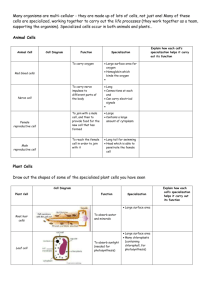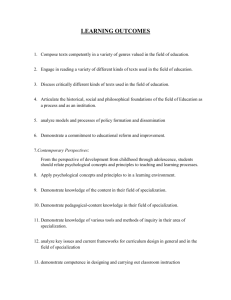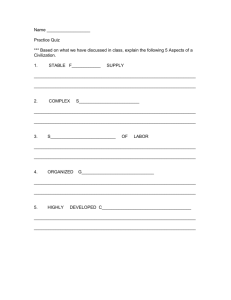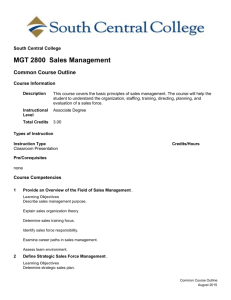Lecture 2: Scarcity and Choices
advertisement
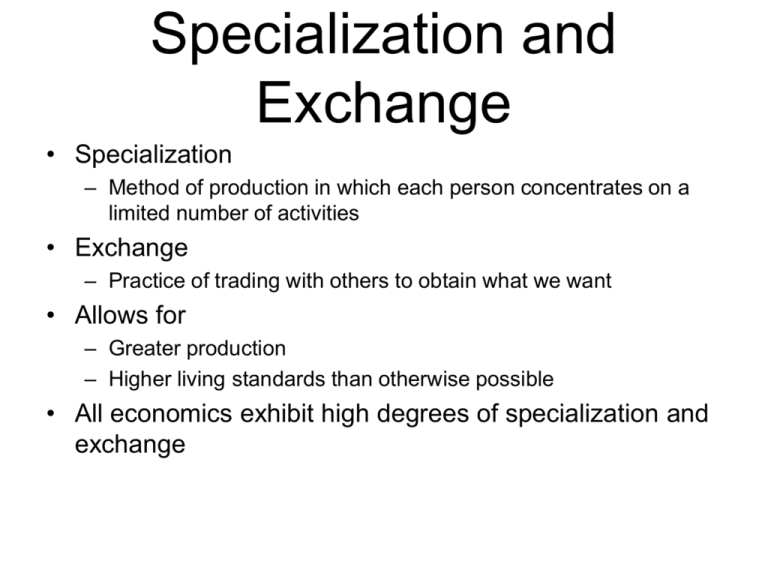
Specialization and Exchange • Specialization – Method of production in which each person concentrates on a limited number of activities • Exchange – Practice of trading with others to obtain what we want • Allows for – Greater production – Higher living standards than otherwise possible • All economics exhibit high degrees of specialization and exchange Further Gains to Specialization • Absolute Advantage: A Detour – Ability to produce a good or service using fewer resources than other producers use • Comparative Advantage – If one can produce some good with a smaller opportunity cost than others can – Total production of every good or service will be greatest when individuals specialize according to their comparative advantage – Another reason why specialization and exchange lead to higher living standards than self-sufficiency Labor Requirements for Berries and Fish Labor Required for 1 cup of Berries 1 Fish Mary ½ hour 1 hour Jim 2 hours 6 hours Mary: opportunity cost of 1 fish= Jim: opportunity cost of 1 fish= Mary: opportunity cost of 1 cup berries= Jim: opportunity cost of 1 cup berries= Jim: Fish↓3 Mary: Fish ↑4 Comparative Advantage & International Trade Labor Requirement per: China United States Suit 125 hours 50 hours Computer 625 hours 100 hours Opportunity cost per: suit computer A small change in production China Suit production +10 Computer production U.S. +4 world Gains from specialization and Trade China Change in Production Exports(-) or Imports(+) U.S. Suits +10 Computers Suits -2 -8 Computers +4 -9 +3 -3 +9 Net Gain As long as opportunity costs differ, specialization and trade can be beneficial to all involved. This remains true regardless of whether the parties are different nations, different states, different countries, or different individuals. It remains true even if one party has an all-round absolute advantage. Specialization in Perspective • While specialization gives us material gains – There may be opportunity costs to be paid in the loss of other things we care about – Example: downside of specialization in family • The right amount of specialization can be found by balancing gains against costs Resource Allocation • Problem of resource allocation – Which goods and services should be produced with society’s resources? • Where on the PPF should economy operate? – How should they be produced? • No capital at all • Small amount of capital • More capital – Who should get them? • How do we distribute these products among the different groups and individuals in our society? • Example: Who should get the scarce donor organs? The Three Methods of Resources Allocation • Traditional Economy – Resources are allocated according to longlived practices from the past • Command Economy (Centrally-Planned) – Resources are allocated according to explicit instructions from a central authority • Market Economy – Resources are allocated through individual decision making The Three Methods of Resources Allocation • Traditional Economy – Resources are allocated according to longlived practices from the past • Command Economy (Centrally-Planned) – Resources are allocated according to explicit instructions from a central authority • Market Economy – Resources are allocated through individual decision making The Nature of Markets • A market is a group of buyers and sellers with the potential to trade with each other – Global markets • Buyers and sellers spread across the globe – Local markets • Buyers and sellers within a narrowly defined area The Importance of Prices • A price is the amount of money that must be paid to a seller to obtain a good or service • When people pay for resources allocated by the market – They must consider opportunity cost to society of their individual actions • Markets can create a sensible allocation of resources Resource Allocation in the United States • Numerous cases of resource allocation outside the market – Such as families • Various levels of government collect about onethird of our incomes as taxes – Enables government to allocate resources by command • Government uses regulations of various types to impose constraints on our individual choice Examples: environment and safety regulations • The market is the dominant method of resource allocation in United States – However, it is not a pure market Resource Ownership • Communism – Most resources are owned in common • Socialism – Most resources are owned by state • Capitalism – Most resources are owned privately Types of Economic Systems • An economic system is composed of two features – Mechanism for allocating resources • Market • Command – Mode of resource ownership • Private • State Figure 4: Types of Economic Systems Resource Allocation Private Market Command Market Capitalism Centrally Planned Capitalism Market Socialism Centrally Planned Socialism Resource Ownership State Economic Systems and This Book • This book will focus on market capitalist economies • About 400 million people have come under the sway of the market in past decade • More are being added as China changes to a market economy • Study of modern economies is study of market capitalism

